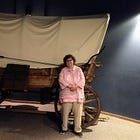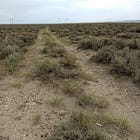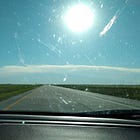West With The Wagons (6): Fear and Water
It's Showtime in 1849! Meet the Scary Prairie, and the River On Which Everybody and Nobody Travels
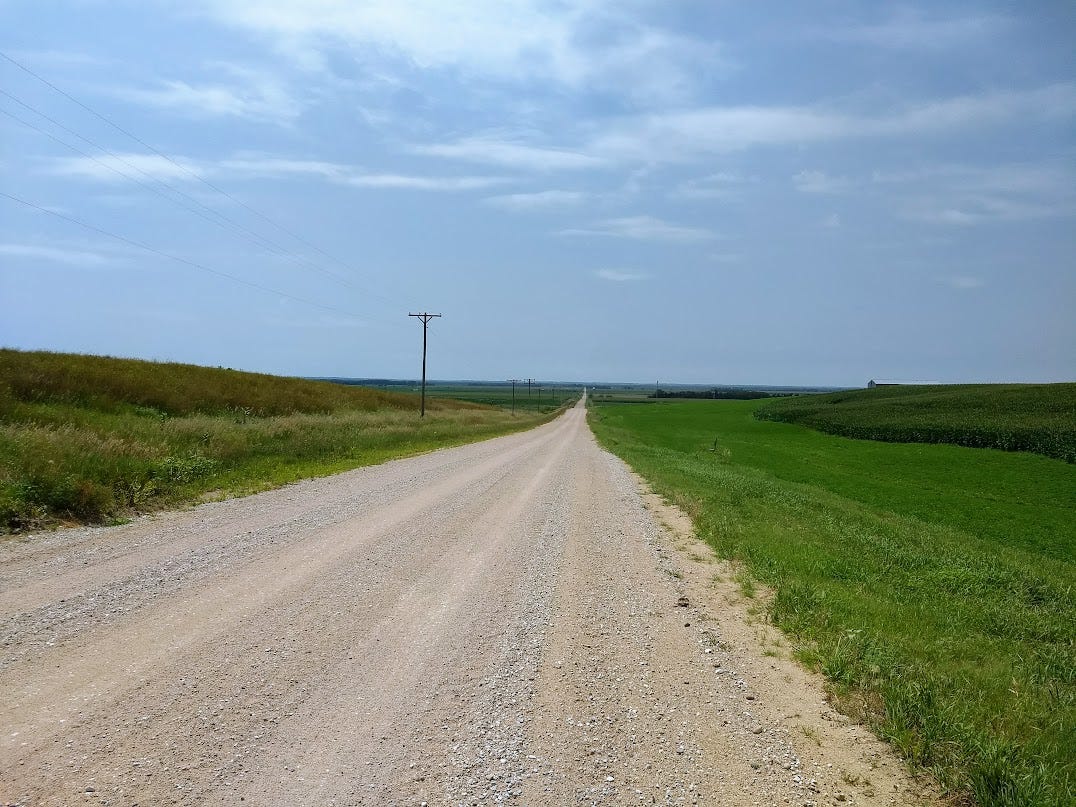
“I think none of us have realized until now the perils of this undertaking.”
— Total understatement by Margaret Frink, thirty-something entrepreneur and digital diary-writing nomad, as it dawns on her that going West to Gold Rush California in 1851 isn’t just a scenic road trip with a quirky RV.
Yes. She was a real person.
Dear Nonnie Friend,
It's the height of summer. Maybe you're lying on a beach. Maybe you're on a cruise. Maybe, like me, you're soaking up the smoke rays at home.
Or maybe you're on the American prairie in 1849, learning to wrangle oxen, and feeling nervous about what and who stands between you and California.
Before we took a break in May from our WWW series here at Non-Boring History, so I could report on my UK adventures, I wrote to you about how Hoosen and I began our 2018 trek along the trail of the Gold Rush.
Having visited the three most important former “jumping off” places, where Gold Rush people and other Westward migrants prepared for their mid-19th century journeys across vast prairie and desert, we had fuelled up our own covered wagon (a rented gerbil-powered Honda) and finally “jumped off” into the West.
Leaving Council Bluffs, Iowa, we 21st century adventurers didn’t have to await a slow ferry for our turn across the Missouri River, as people did in 1849. Nope. Hoosen simply drove us across a very boring and ugly (yet convenient) cement bridge.
We didn’t land on the jaw-droppingly vast open prairie, either, but found ourselves dropped among the stocky skyscrapers of downtown Omaha, Nebraska.
Hey, times change over nearly 200 years. One plus: Omaha is home to one of the very few Midwest branches of California’s beloved See’s Candies stores! See's is only here because the company is owned by legendary investor Warren Buffett, and he lives in Omaha! Despite rumors, I can confirm that Buffett wasn't one of the original investors in the Gold Rush.
About WWW: A Message from the NBH Gnomes
The first five episodes of WWW, plus the intro post are on the keyword-searchable Non-Boring History site (http://annettelaing.substack.com) , as are all the NBH posts since this began in 2021! Access is an exclusive perk for Nonnies (paid subscribers)
As a Nonnie, you not only get exclusive access to special series and posts like WWW, but you can comment if you wish, and read everything at your own pace from the NBH site, without having to rummage through your emails.
No rush, no pressure, no tests. Just a gentle mystery tour through history in the NBH luxury limo, driven by a Gnome chauffeur. Plus you’re making it possible for Annette to write about history for normal people in a way that’s not just trivia, not just clickbait, and not just an excuse to complain about Presidents Trump OR Biden.
This is a warm and personal historian-created portal to a world of history most people don't know exists, but is the life’s work of academic historians and museum curators everywhere. Thank you for your continuing support in helping connect NBH to people.
Oh, and become a SuperNonnie (Patron) and the NBH Gnomes will create a shrine for you at Non-Boring House! We will also send you a Thank You Gift: Your choice of an NBH T-shirt or NBH mug!
For education and entertainment, you can’t beat Non-Boring History!
Running Out of Imagination
Honestly, while I love using my historical knowledge and imagination in traveling across modern landscapes, trying to see them as people did in the past, this isn't easy. And my brain was working overtime on this journey, as we followed freeways through city streets and hideous post-1990 suburban sprawl that makes every bit of America look like . . . Every other bit of America.
To be fair, the first few days of our trip had been fascinating, what with tempting traces of actual wagon trails (hard to see though they were), and absorbing museum visits.
But I was beginning to despair of ever feeling fully transported back to 1849.
After visiting Independence, the original “jumping off point” where people packed their wagons and prepared to go West, we had, as you may recall, jumped on the freeway and sped north to have a quick look at the other two major “jumping off” places, St. Joseph, Missouri, and Council Bluffs, Iowa.
Even when we finally headed West, from Council Bluffs, we were still on the freeway. After taking the dreary bridge across the Missouri, we ran into downtown Omaha, bless it, which, as I described in Episode 5, gamely tried to immerse us in the 19th century with an awesome series of statues of wagons, people, buffalo, and even fake mud.
We enjoyed time-travel moments like these. But there was no disguising the fact that our actual journey was taking place in the 21st century.
Our first night after “jumping off”, we did not sleep in a tent on rough ground in Indian lands. Good Lord, no! I’m not a camping person.
Instead, we put up at a hotel in suburban Omaha. We ate dinner at a local brewpub, where I ordered the fancy sausage and mash special. This might have been a bit like what the migrants ate in camp, but, nah, probably not.
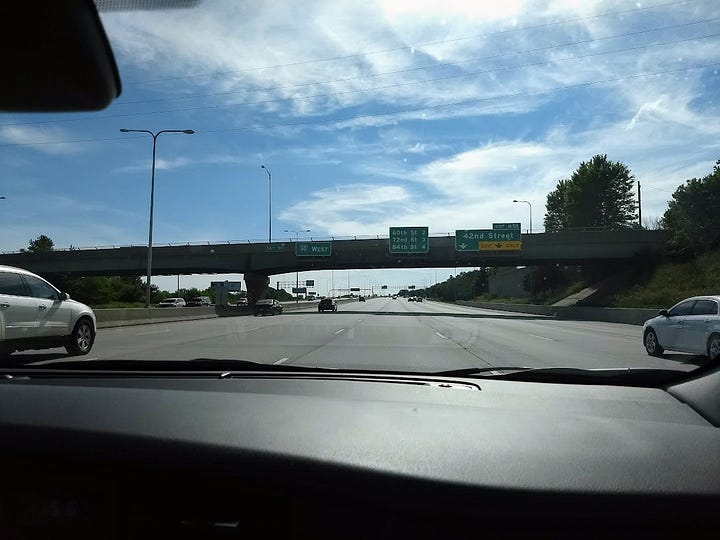

So what was this stage of the journey like for the wagon people of 1849 who now found themselves coming face to face with the reality of life on the trail?
Their next destination would unite them with the migrants coming from Independence. Check the maps in previous WWW episodes, or Google Maps, or just nod wisely. Whatever works for you. I won’t judge.
That's because everyone was headed to the Platte River. It was to be their guide to going West. But they had to get there first. The people from Independence, having followed the Santa Fe trail and then turned off it, were coming from the southeast. Everyone else was coming west. Soon they would all meet.
Margaret Panics (and so do the men)
While Omaha has violent crime, like any American city, I didn’t stay up all night worrying about being attacked. The same was not true of Gold Rusher Margaret Frink. Having crossed the Missouri River at St. Joseph in 1851, she looked around at the open prairie, and had a huge anxiety attack when she thought about the situation she and her family were now in.
Over the previous week, as the Frinks camped awaiting a turn on the ferry that crossed the Missouri River, handbills had been distributed among the migrants in Margaret’s camp. These cheery little flyers warned the reader of fatal Indian attacks.
Margaret could not, of course, know that these handouts were clever advertising, which were ahead of their time, because they didn't directly sell a product. Instead, like ads today, they aimed to induce anxiety, and their goal was to encourage gun sales by frightening the migrants.
Now, Margaret worried that her husband’s rifle and Colt pistol would not be sufficient to defend three men, one woman (herself), and one eleven year old against “many hostile Indian tribes” across 2,000 miles of nowhere.
On this first day of crossing the plains, Margaret had hinted to her husband, Ledyard, that they should join up with a larger wagon train, for safety’s sake. “But when camping time came,” she wrote, “late in the afternoon, and night was drawing nigh, our little party was all alone.”
They found what Margaret called a “rolling knoll” in which to camp, behind a little ridge where Margaret reckoned they might have a better chance of defending themselves if attacked. But, she complained, none of her men seemed concerned about the Indians: Her husband Ledyard, their informally adopted teen and kid sons, the hired man, all the guys, told her they weren't worried.
Margaret was not impressed by their bravado. She wrote that “the first thing I did after we halted was to get out the field telescope we carried, to see if I could find any Indians.”
And right away, she did.
Margaret spied a group of Natives riding along a hilltop in the far distance. Honestly, they were clearly minding their own business. But let's think about this: Margaret had been primed by flyers and newspapers to see all Indians as potential murderers. Don't forget, too, that women are socialized to be cautious of strangers and potential danger, and for good reason.
Margaret immediately alerted her men. As soon as they saw what she saw, they promptly forgot to be cool: They scrambled to make defense plans, and you can feel their panic echoing through Margaret’s diary. So if you have been tempted Margaret a “Karen” (a misogynist term I refuse to use), knock it off this instant.
Now, a group of wagon migrants from Michigan turned up, and asked if they could camp alongside. The relieved Frinks didn’t need to be asked twice. They warned the men about the faraway Indian “scouts”. Now, the entire group decided to circle the wagons.
But here, friends, is where our confusion starts, including mine. The historians I have read have assured me that, contrary to old Westerns, circling the wagons was done not for defense, but to contain the livestock, so the animals couldn’t be lost or stolen, or run off in panic.
Margaret’s account, however, suggests that she—if nobody else—saw the corral at least in part as a fort. Interesting.
I can only add that Westward migrants circled their wagons even when they didn’t have the least fear of Indians attacking them. The possible theft of their horses did worry them.
Since there were Indians in the Frink party's vicinity, all the men, including the guys from Michigan, were assigned “watches”, shifts as nightwatchmen.
All the men, that is, except Margaret’s sensible husband, Ledyard. He figured that since everyone else, including his wife, was terrified and wouldn’t catch a wink, he wasn’t needed. He retired to bed, in his luxury wagon.
Yes, unlike virtually every other migrant going West, the Frinks, successful middle-class merchants, really did use the wagon as an RV. They even had an air bed. This was, I promise, highly exceptional, i.e. almost everyone else slept in tents.
While Ledyard went off to Dreamland, Margaret sat bolt upright, her shoes and hat on. She kept an eye out to make sure the watchmen stayed awake. Not that she could see them in the dark.
Despite the guards often reporting back to her, assuring her that “no Indians have been seen yet”, Margaret did not let down her guard. She prodded Ledyard awake every time he seemed in danger of entering deep sleep. “I could not understand,” she wrote with more than a note of irritation, “how he could sleep soundly when there was so much danger.”
You will be pleased, but possibly not be surprised, to learn that the entire group survived what Margaret called (tellingly) “our first night on those vast uninhabited plains”. Indians did not, to her, count as “inhabitants”.
But please don’t laugh at Margaret, or grab your wokey hammer and start attacking her: If we were Margaret Frink, in the quiet of the open plains, and had read alarming leaflets and sensational newspaper accounts of attacks on people like us, and had never seen the West, much less traveled through it, might we be nervous? Yes, we probably would: Everyone except Ledyard was. But then Ledyard is a cool customer.
Instead of worrying, would we instead welcome the opportunity to engage Indigenous people, and learn about their fascinating cultures, possibly while deflecting hatchet blows? No. No, we wouldn’t.
This is where historical empathy comes in, as we try to understand what happened on these journeys across the mid-19th century West. First, we have to admit to ourselves that everyone is ignorant about something, including us. And then we have to step into their shoes, as we should step into the shoes of so very many different people who thought (and think) differently than us, if we are ever to catch a glimpse of the past, and of the present.
As WWW continues, we will keep an eye on the Frinks. Longtime NBH readers may recall that they are a fascinating couple:
From this campsite, the Frinks, their wagons, and their animals, took four days to reach the south bank of the Platte River. As it did for thousands of others, the Platte served as the wagon people’s map across the Great Plains. Which doesn’t make it a great river. In fact, as rivers go, it kind of sucks.




